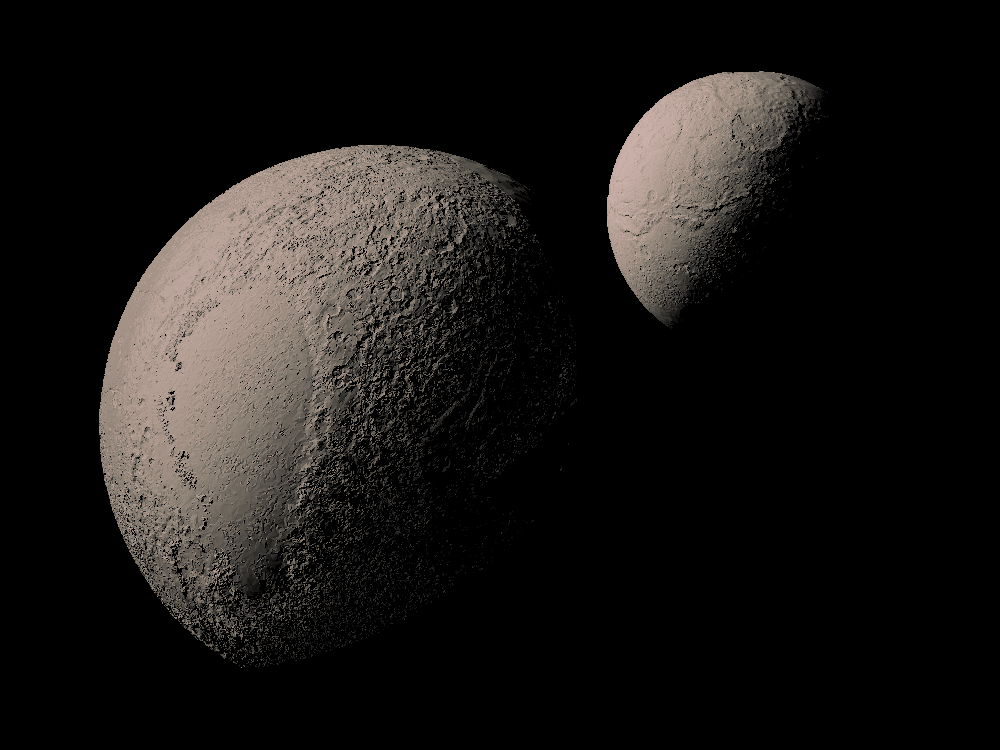
Pluto and Charon with known topography scaled one in ten million
prusaprinters
<p>Originally published here: <a href="https://www.thingiverse.com/thing:3321413">Pluto and Charon with known topography scaled one in ten million by tato_713 - Thingiverse</a></p><p>This model is made using MATLAB R2016a on the topography map from the USGS Astrogeology Science Center site, from the data of the New Horizons mission. The original maps have the known topography only, the rest of the minor planets surface topography is unknown because of the low resolution of the images and because some parts of the bodies were in complete darkness at the time the probe made its flyby. It's scaled to 1 in 107 or <a href="https://www.thingiverse.com//tato_713/collections/one-in-ten-million-scale">one in ten million</a>. The topography of Charon is scaled to the real value; while the one of Pluto is exaggerated 3 times, to make the features visibles and suitable for printing. The Pluto model is about 22cm in diameter and Charon 12cm. On this scale the Moon is a basketball, and Mars' moons Phobos and Deimos are 2 and 1 mm respectively. It's also included a one in twenty million scaled version because some printer may not be able to print at the prior scale.<br>The distance between Pluto and Charon in the image is not in scale.</p><p>The file's names explained: <i>name_1_x_10_y.stl</i> is 1 : x* 10^y. So _1_6_10_7 is 1:600000000 or one in 60 million. </p><h4>134340 Pluto</h4><p>Pluto is the biggest dwarf planet by diameter and the second by mass after Eris. Pluto was first considered as a planet, definition that was dubbed after the discovery of other similar objects like <a href="https://www.prusaprinters.org/prints/57288-largest-tnos-and-their-moons-shapes-scaled-one-in-">Eris, Makemake and other trans neptunian objects</a>, and triggered the 2006 planet redefinition. The most notable surface feature on Pluto is the Sputnik planitia, a depression with a half heart shape, higher albedo (aka whiteness), possibly originated by an impact of another body.</p><ul><li><strong>Type:</strong> Dwarf planet. TNO. Plutino. Binary </li><li><strong>Orbit:</strong> Sun. Kuiper belt </li><li><strong>Orbital period:</strong> 248 yr. </li><li><strong>Composition:</strong> Icy body. Differentiated interior. </li><li><strong>Density:</strong> 1.854 g/cm3. </li><li><strong>Dimensions:</strong> 2376.6 km. </li><li><strong>Model scale:</strong> 1:1x107 (24cm) 1:2x107 (12cm)</li></ul><h4>(134340 Pluto 1) Charon</h4><p>Charon is the main satellite of Pluto, and it's so big, that the barycenter between them is outside Pluto. After that, some authors consider the system Pluto-Charon a binary dwarf planet. The other satellites of Pluto (<a href="https://www.thingiverse.com/thing:4284631">Styx, Nix, Kerberos and Hydra</a> in order of distance from Pluto) are too small to make them in the same scale.</p><ul><li><strong>Type:</strong> Binary. </li><li><strong>Orbit:</strong> Pluto. </li><li><strong>Orbital period:</strong> 6.387 d. </li><li><strong>Composition:</strong> Icy body. Differentiated interior. </li><li><strong>Density:</strong> 1.702 g/cm3. </li><li><strong>Dimensions:</strong> 1212 km. </li><li><strong>Model scale:</strong> 1:1x107 (12cm)</li></ul><h4>References</h4><ul><li><a href="https://astrogeology.usgs.gov/search/map/Pluto/NewHorizons/Pluto_NewHorizons_Global_DEM_300m_Jul2017">Map of Pluto</a></li><li><a href="https://astrogeology.usgs.gov/search/map/Charon/NewHorizons/Charon_NewHorizons_Global_DEM_300m_Jul2017">Map of Charon</a></li><li><a href="https://www.mathworks.com/matlabcentral/fileexchange/4512-surf2stl">Surf to STL function for MATLAB</a></li></ul><h3>Other astronomical objects</h3><p><a href="https://www.prusaprinters.org/social/120859-tato_713/collections/49826">Inner Solar System</a></p><p><a href="https://www.prusaprinters.org/social/120859-tato_713/collections/49832">Artificial</a></p><p><a href="https://www.prusaprinters.org/social/120859-tato_713/collections/49820">Near Earth Asteroids</a></p><p><a href="https://www.prusaprinters.org/social/120859-tato_713/collections/49291">Main Belt Asteroids</a></p><p><a href="https://www.prusaprinters.org/social/120859-tato_713/collections/49829">Jovian System</a></p><p><a href="https://www.prusaprinters.org/social/120859-tato_713/collections/49828">Saturn System</a></p><p><a href="https://www.prusaprinters.org/social/120859-tato_713/collections/49830">Uranian System</a></p><p><a href="https://www.prusaprinters.org/social/120859-tato_713/collections/49345">Neptunian System</a></p><p><a href="https://www.prusaprinters.org/social/120859-tato_713/collections/49827">Centaurs</a></p><p><a href="https://www.prusaprinters.org/social/120859-tato_713/collections/49833">Comets</a></p><p><a href="https://www.prusaprinters.org/social/120859-tato_713/collections/49341">Trans Neptunian Objects</a></p><p><a href="https://www.prusaprinters.org/social/120859-tato_713/collections/49824">Extrasolar Objects</a></p><p><a href="https://www.prusaprinters.org/social/120859-tato_713/collections/49837">Sky Maps</a></p><p><a href="https://www.prusaprinters.org/social/120859-tato_713/collections/49831">Ancient</a></p><p><a href="https://www.prusaprinters.org/social/120859-tato_713/collections/49822">Speculative</a></p><p><a href="https://www.prusaprinters.org/social/120859-tato_713/collections/49821">Science Fiction</a></p>
With this file you will be able to print Pluto and Charon with known topography scaled one in ten million with your 3D printer. Click on the button and save the file on your computer to work, edit or customize your design. You can also find more 3D designs for printers on Pluto and Charon with known topography scaled one in ten million.
